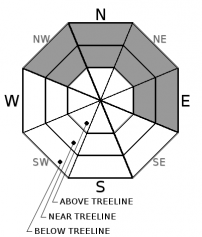| Sunday | Sunday Night | Monday | |
|---|---|---|---|
| Weather: | Partly cloudy | Mostly cloudy | Mostly cloudy |
| Temperatures: | 50 to 55 deg. F. | 32 to 37 deg. F. | 47 to 52 deg. F. |
| Mid Slope Winds: | Variable | Variable | South |
| Wind Speed: | Light | Light with gusts to 25 mph after midnight | Light in the morning increasing to 10 to 15 mph with gusts to 40 mph in the afternoon |
| Expected snowfall: | 0 | 0 | 0 |
| Sunday | Sunday Night | Monday | |
|---|---|---|---|
| Weather: | Partly cloudy | Mostly cloudy | Mostly cloudy |
| Temperatures: | 47 to 52 deg. F. | 33 to 38 deg. F. | 44 to 49 deg. F. |
| Ridge Top Winds: | Variable | Southwest | South |
| Wind Speed: | Light | 15 to 20 mph with gusts to 25 mph increasing to 45 mph after midnight | 20 to 30 mph with gusts to 60 mph |
| Expected snowfall: | 0 | 0 | 0 |
























